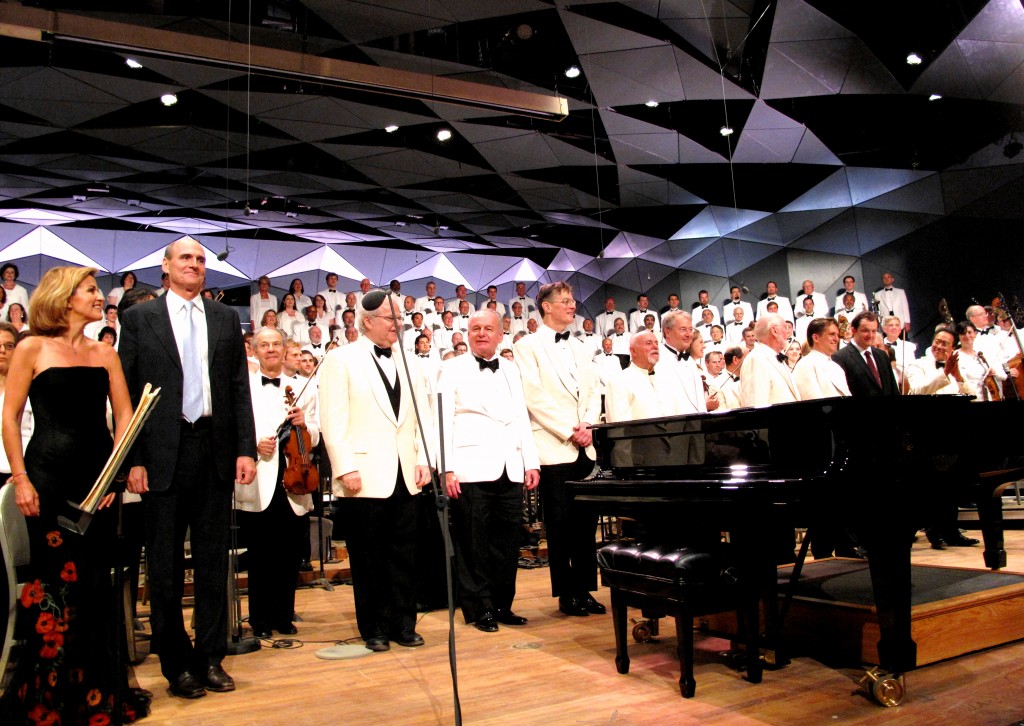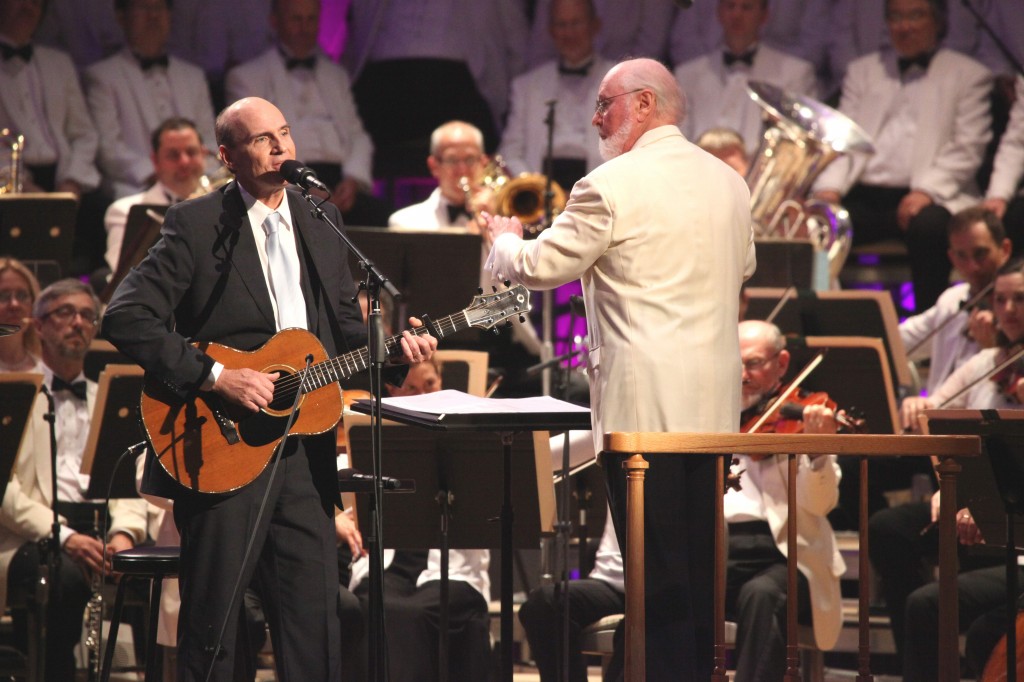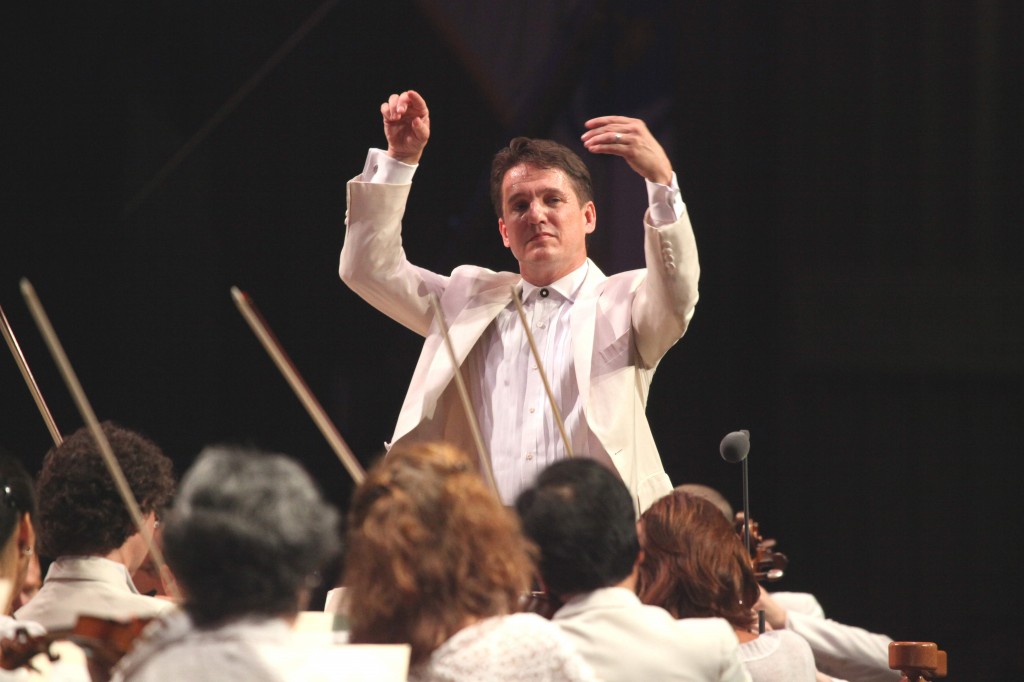Concert Review: Tanglewood’s 75th Birthday Shindig — Boston Symphony Orchestra, Tanglewood Festival Chorus and Guests
After several years of frustrating cancellations and artistic challenges, Tanglewood and the Boston Symphony Orchestra seemed to be saying that there’s still much to celebrate. And they were right.
By Jonathan Blumhofer

The line-up of gathered luminaries receive the grateful ovations of the large crowd at the close of the gala Tanglewood concert event. (L-R) Annie-Sophie Muller, James Taylor, Emanuel Ax, John Oliver, Peter Serkin, David Zinman, Stefan Asbury, John Williams, Keith Lockhart, Andris Nelson, and Yo-Yo-Ma. Photo: Ron Barnell
The 75th birthday of the Boston Symphony Orchestra’s (BSO) summer home at Tanglewood was celebrated in grand fashion Saturday night with a gala concert that featured the BSO, Boston Pops, Tanglewood Music Center Orchestra (TMCO), and the Tanglewood Festival Chorus (TFC). Anne-Sophie Mutter, Yo-Yo Ma, Emmanuel Ax, Peter Serkin, and James Taylor took solo turns with the various ensembles, which were conducted by no less than five maestros: Keith Lockhart, John Williams, Stefan Asbury, Andris Nelsons, and David Zinman. If the musical excitement wasn’t enough, the evening was capped off with a spectacular fireworks show that held its own to Boston’s Fourth of July festivities. After several years of frustrating cancellations and artistic challenges, Tanglewood and the BSO seemed to be saying that there’s still much to celebrate. And they were right.
Conspicuously absent from the proceedings were the BSO’s two surviving former music directors, Seiji Ozawa and James Levine. Both have been felled by health problems in recent years, though their respective tenures were cited in the film Music Under the Moon, which was shown during the gala’s first half. Mr. Ozawa’s long connection with Tanglewood and the BSO was also recalled in the second half of the program when Mr. Williams and Mr. Ma presented him, in absentia, with the inaugural Tanglewood Medal. Mr. Ma read a gracious message of thanks from Mr. Ozawa in which the conductor mentioned his desire to return to the BSO podium and Tanglewood. May that day come soon.
The musical portion of Saturday’s performance began with the Boston Pops performing works by two composers with long Tanglewood associations, Aaron Copland and Leonard Bernstein. Copland’s Fanfare for the Common Man, last played by the BSO brass and percussion at Symphony Hall in January, made a thoroughly appropriate opener for the evening. The stirring, noble rising fourths of Copland’s melody set a tone of populism and serious music making that, by and large, carried through the evening.
The “Three Dance Episodes” from Bernstein’s 1944 musical On the Town followed. It is perhaps folly to make comparisons between Bernstein’s performances of his own music and that by other conductors, but I couldn’t help myself here. Mr. Lockhart led the Pops in a wholly competent performance, though some of the pop and flamboyant energy one hears in Bernstein’s recordings of these pieces was lacking in the outer dances. Where, in Bernstein’s take, there’s a wildness to the concluding bars of the first movement (“The Great Lover”) and manic, New York City energy to the third (“Times Square: 1944”), the Pops and Mr. Lockhart played it safe, opting for overall slower tempos and restraint. It was an interpretation that worked but left me wanting more. The slow second movement (“Pas de deux”), based on the song “Some Other Time,” though, was beautifully played. Principal trumpet Thomas Rolfs made the most of his soulful, bluesy solos in the second and third movements, while saxophonist Michael Monaghan brought swinging, ‘40s character to his turn in the finale.
The evening’s strangest pairing involved the two artists on the program who, on their own, regularly pack Tanglewood to the gills, Mr. Taylor and Mr. Williams, performing three selections from the “Great American Songbook.” As a folk-rock singer, Mr. Taylor is one of the most distinguished and successful popular musicians of the last 40 years. His catalog of songs is extensive and, at this point in his career, bordering on iconic: “Carolina On My Mind,” “Sweet Baby James,” and “Steamroller” are James Taylor, after all. The standards that he sang on Saturday, though—Harold Arlen’s “Over the Rainbow” (with lyrics by E. Y. Harburg), Richard Rogers’s “Shall We Dance?” and Jerome Kern’s “Ol’ Man River” (both with lyrics by Oscar Hammerstein)—do not figure prominently in his repertoire, nor does the practice of singing without a guitar (as he did for the first two numbers). Accordingly, in “Over the Rainbow” and “Shall We Dance?” he looked and sounded distinctly uncomfortable and a bit out of place.
When he brought out his guitar to begin “Ol’ Man River,” things quickly settled down, and the James Taylor with whom his legions of fans are familiar suddenly showed up. If only the whole set could have taken better advantage of Mr. Taylor’s strengths or, better, been devoted to “The Great James Taylor Songbook”—I’m sure no one at Tanglewood would have minded that. Still, hats off to Mr. Taylor for stepping outside his comfort zone and trying something different. The Pops, playing under their laureate conductor, made the most of Gil Goldstein’s arrangements, supporting Mr. Taylor’s voice but not overwhelming him at any point.
It was a pity that the TMCO was relegated to the status of backing band for the evening’s three other soloists: they are, perhaps, Tanglewood founder Serge Koussevitzky’s most vital living legacy, and their season this year is packed with meaty repertoire. It would have been nice to hear them perform something in their own right. Even so, they fulfilled their subsidiary role admirably and, from what could be gleaned from my seat, enthusiastically.
Still, I could have done without Emmanuel Ax’s selection of two movements from Haydn’s D major Piano Concerto, beautifully played as it was. For whatever reason, Haydn’s keyboard works (a few solo sonatas notwithstanding) have often left me cold, and this decidedly underwhelming concerto was no exception. Not that there was really anything to fault in Mr. Ax’s performance of it: his playing was crisp, nuanced, and sensitively phrased. He and the TMCO (here conducted by Mr. Asbury) brought out Haydn’s characteristic humor and joie de vivre. Still, this concert would have been a fine showcase for some other underplayed repertoire, like Mendelssohn’s Capriccio Brilliant or, perhaps, a movement from Tchaikovsky’s neglected Concert Fantasy.
Mr. Ma’s performance of Tchaikovsky’s Andante cantabile for cello and strings, arranged by the composer from the second movement of his String Quartet no. 1, was nothing short of transcendent. Mr. Ma is a rare breed of artist, one for whom critical praise rarely does his playing justice and criticism is virtually non-existent. To paraphrase an English colleague of mine, on hearing his performance you sit back, fold up your program, thank your lucky stars that you in the audience that night, and go home happy. So it was Saturday, with Mr. Ma pouring forth streams of liquid, golden tone that reached through the Shed, across the lawn, and evaporated into the warm, Berkshire air.
While Mr. Ma is a regular Tanglewood guest, Anne-Sophie Mutter has hardly been a presence at the festival (this season marks only her second appearance in Lenox: her first was in 1992). She is very familiar to Symphony Hall audiences, though, most recently opening the 2011-12 season as soloist and conductor. Ms. Mutter reprised part of that all-Mozart program from September on Friday night, but on Saturday turned to more show stopping fare with Pablo de Sarasate’s Carmen Fantasy. Her performance of the Fantasy could be described as smartly showy, filled with muscular virtuosity, Romantic sensibility, and a strong sense of the melodic line. Andris Nelsons ensured the TMCO was with her (and Mr. Ma, for that matter) every step of the way.
After intermission, the BSO took the stage to close the concert with music by Ravel and Beethoven. On paper, Ravel’s La Valse is a somewhat curious inclusion on a celebratory program: written in the shadow of the Great War, it’s a score haunted by the then-recent past, conjuring up a vision of a Viennese ballroom that dissolves into a kind of mechanized cataclysm at the end. It’s not all grim, though, at least not in Mr. Nelsons’ reading, which was big on sumptuous orchestral color, if light on narrative drama. If nothing else, it whetted the appetite for his scheduled Symphony Hall debut in January.
To round out the evening, the BSO turned to the sibling of one of its Tanglewood staples, Beethoven’s Fantasy for piano, chorus, and orchestra. Popularly known as the “Choral” Fantasy, it’s part piano concerto, part theme and variations, part choral symphony: if any score is more than the sum of its parts, this is the one. On Saturday, the Fantasy filled the bill ideally. Peter Serkin brought a breathtaking, improvisatory quality to his solos, particularly the opening cadenza. Mr. Zinman, conducting the BSO, TFC, and soloists drawn from the past and current roster of TMC vocal fellows, superintended over a performance that was almost stately to a fault. While one wished for slightly brisker tempos, especially during the closing chorus, Beethoven’s ostinati pack an extra punch when held back a bit and so they did here. The overflowing grounds (estimates put attendance at over 15,000) responded with a thunderous ovation.
If you weren’t able to attend or want to enjoy the event again, you’re in luck: PBS recorded the entire gala for a Great Performances broadcast on August 10th (sans post-concert fireworks, sadly).
Tagged: Andris Nelsons, Anne-Sophie Mutter, Boston Pops, Boston Symphony Orchestra, David Zinman, Emmanuel Ax, James Taylor, John Williams, Keith Lockhart, Peter Serkin, Stefan Asbury, Tanglewood, Tanglewood Festival Chorus (TFC), Tanglewood Music Center Orchestra (TMCO)



I had an occasion to speak to one of the PBS people involved in the production of the Tanglewood 75th Anniversary Concert broadcast last Saturday night — and he hinted that there could be a possibility of the concert recording to be eventually put out on a Blue-Ray DVD.
I can think of no finer lasting tribute to an extraordinary musical event
than to be able to relive this in hi-def video and audio.